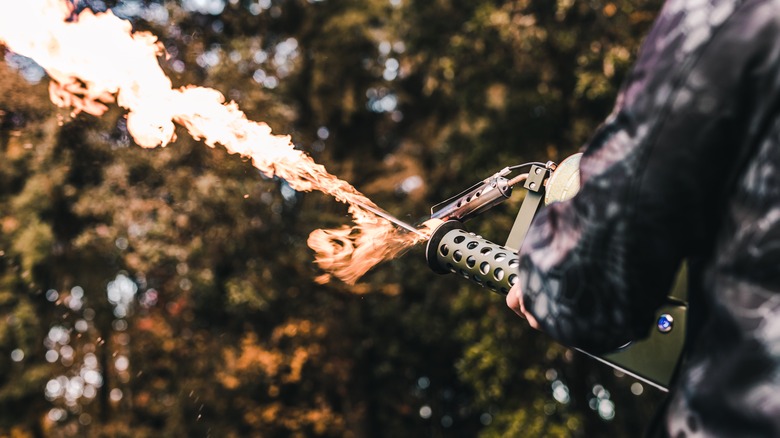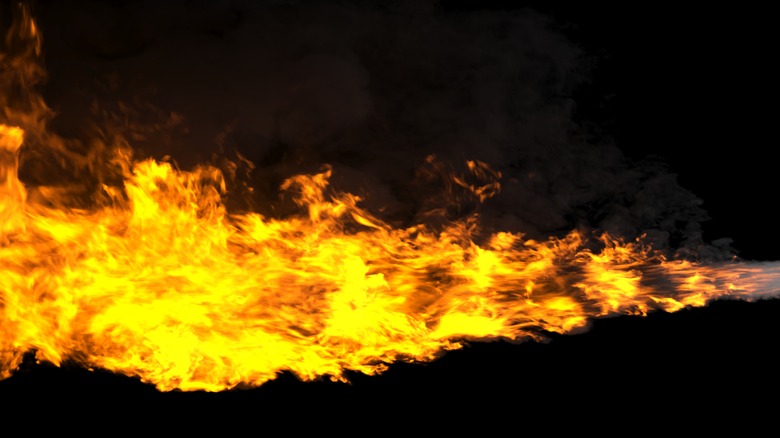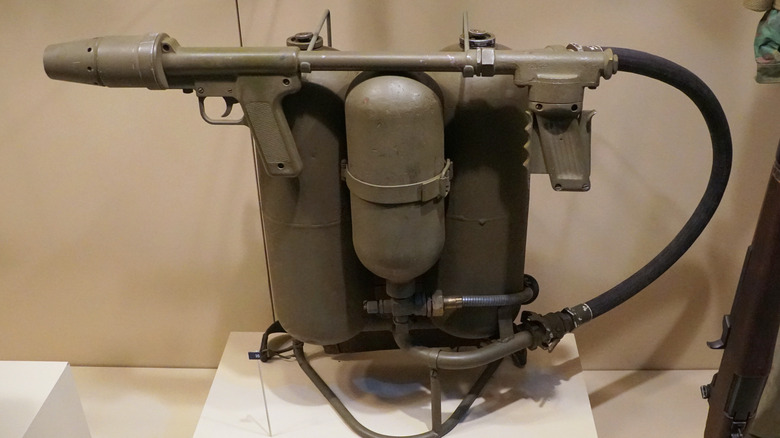Here's How A Flamethrower Really Works
The moment mankind discovered fire was the moment it rocketed to the pointy tip of the food chain. It is through the harnessing of fire that we've achieved all of our greatest advancements, from rapid travel to wide-scale energy development. Of course, fire may be one of our most important tools, but it is, at its core, a force of destruction, breaking down even the most stalwart of physical bonds and leaving nothing but ash and soot behind.
Fire-based weaponry has been something of a sore spot in modern warfare, as while it is naturally fantastic at clearing out enemies and emplacements, it's also an unimaginably cruel thing to willingly inflict on a living being. Perhaps one of the most well-known of these tools is the infamous flamethrower, a bunker-buster designed to spray targets with a concentrated stream of fiery doom. Putting aside the cruelty aspect for just a moment, how does a weapon like this actually work?
Old and new concepts
The original concept for flame-based weapons involved effectively hurling burning materials right at an enemy's face. Ancient flamethrowers were just big metal tubes full of hot coals that combatants would blow into to launch them at foes, particularly naval vessels. They were crude, but effective, at least as long as you had a big pit of hot coals on standby and didn't mind putting your mouth on what was effectively a stovepipe.
In the modern era, though, circa World War I, flamethrowers were upgraded significantly into the handheld, back-mounted weapons we know today. By utilizing a propulsion mechanism attached to fuel tanks, infantrymen could cart around the chemicals necessary to spark off a fire without exposing themselves to the heat. With a simple pull of the trigger, they could expel a concentrated blast of fire in any direction. The only downside was that those chemical tanks made the user a priority target for enemy fire, which is why flamethrowers were usually protected by a squad of bodyguards.
Mechanics of a flamethrower
The modern handheld flamethrower is made up of three primary components- the cylinder tanks, the gun housing, and the ignition system.
A typical flamethrower pack has three cylinder tanks, two containing flammable fuel and one containing flammable gas. The fuel can be either liquid or gel, depending on the needs of the situation. Liquid fuel like oil or kerosene is easier to haul, but a little harder to ignite, while gel fuel like napalm flies further but can be harder to prepare and move. All of this fuel is kept in a pressurized tank, so if the pressure is adjusted, the fuel will immediately come shooting out.
Both the fuel and the gas are fed into the gun housing via separate tubes. The gun housing has an exit point on the end for the fuel, as well as a stopper at the back that plugs up the tubes. When the trigger is pulled, the stopper is opened, and the fuel starts flowing. Meanwhile, the gas is regulated via the ignition valve. When the valve is activated, gas flows to a small burner at the front of the gun housing and is ignited by a spark plug, creating a small, yet sustained flame. It's like a pilot light on your stove.
Once the burner is active, the trigger is pulled, the fuel flows through the casing, and passes through the burner's flame, igniting on its way out. Just like that, a stream of fire is born.


